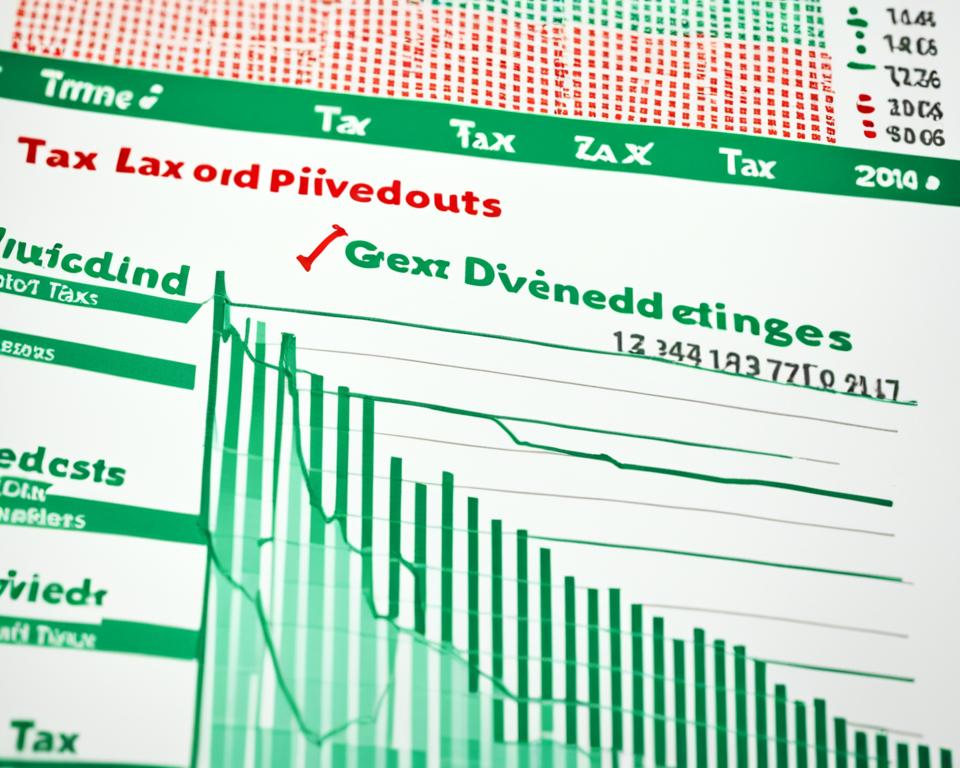As you traverse the intricate world of investing, understanding tax laws for dividend earnings becomes a cornerstone for optimizing your portfolio’s performance. Tax laws have a significant bearing on your financial journey, shaping the course of action you take with dividend-yielding assets. A keen grasp of these regulations offers insights that empower you to navigate the effects of tax laws on dividend yields adeptly.
The landscape of investment taxes is continually evolving, placing the onus on you to stay agile. Changes in legislation may tip the scales, affecting everything from the dividends you pocket to the strategic moves you make with your stocks. Whether you’re a seasoned investor or just starting out, a clear understanding of how tax laws impact dividend investing is vital to your success.
Key Takeaways
- Recognizing the interaction between tax regulations and dividend income is essential for effective portfolio management.
- Differentiating between qualified and non-qualified dividends can lead to significant tax savings.
- Anticipating legislative shifts can help you refine your dividend investing strategy and enhance after-tax returns.
- Investment holding periods greatly influence how your dividend earnings are taxed.
- Staying informed on tax code changes enables proactive adjustments to your investment approach.
Grasping Tax Fundamentals for Dividend Investors
When you dive into the sea of dividend investing, the waves of tax regulations are a force you must reckon with to ensure your financial vessel is steering correctly. Being versed in the tax laws that impact dividend investing can differentiate between navigating smoothly to your financial goals or finding your returns washed away by unexpected tax implications.
The Role of Taxation on Dividend Income
Every savvy investor knows that dividends can be a significant source of income. However, navigating the tax implications for dividend investors requires a thorough understanding of how different dividend types interact with tax regulations. Dividends from your investments can be the nectar of your financial endeavors, but without proper tax handling, could also become a financial burden.
Comparing Qualified and Non-Qualified Dividends
Your journey through the investment landscape will likely lead to encounters with two distinct types of dividends: qualified and non-qualified. Herein lies a crucial decision point because your tax burden hinges on understanding these distinctions under the ever-watchful eye of the IRS. Let’s unfold their differences:
| Dividend Type | Tax Rate | Criteria | Impact on Returns |
|---|---|---|---|
| Qualified Dividends | Lower tax rates akin to long-term capital gains | Must originate from a U.S. corporation or a qualified foreign corporation; subject to holding period criteria | Enhances after-tax returns |
| Non-Qualified Dividends | Higher, ordinary income tax rates | No stringent criteria on corporation type or holding period | Higher tax cost, reducing after-tax returns |
Tax regulations on dividend income clearly set apart the preferential treatment given to qualified dividends, which, when leveraged correctly, can amplify your after-tax investment earnings. Recognition of these dividends aligns with advantageous long-term capital gains tax rates, provided the dividends hail from either a domestic corporate powerhouse or an adequately-sanctioned foreign entity—all within proper timing.
In contrast, non-qualified dividends do not enjoy such beneficial tax rates and will amalgamate with your ordinary income, potentially skyrocketing your tax liability. Diligent consideration to how the tax laws impact dividend investing will illuminate how your holdings should be diversified to reap the maximum fiscal advantage.
Ultimately, understanding the nuances of these categories will arm you with the knowledge to plot a course towards tax-efficient dividend strategies. Stay vigilant, for tax laws are ever-changing winds, and keeping a keen eye on them is imperative for your financial expedition to prosper.
Capital Gains Tax Essentials
As an investor seeking to understand how tax laws influence dividend stocks, it’s paramount to grasp the essentials of capital gains tax. The influence of these taxes on your investment portfolio cannot be overstated, as they directly affect the profitability of your dividend-yielding assets. Capital gains tax applies when you sell an asset for more than you paid for it, and the rate at which you’re taxed hinges on the duration of your investment.
These taxes are bifurcated into short-term and long-term categories, each with different tax implications. This dichotomy is integral to structuring your portfolio in a tax-efficient manner and can lead to considerable differences in your after-tax returns.
Short-term vs Long-term Capital Gains Tax Rates
When evaluating dividend stocks, understanding the difference between short-term vs long-term capital gains tax rates is crucial. Short-term capital gains are incurred when you sell an asset held for one year or less. These gains are taxed at the standard income tax rates, which can range significantly depending on your bracket. Conversely, long-term capital gains arise from the sale of assets held for more than one year. Beneficially, long-term gains are taxed at reduced rates, which, for many investors, can create a substantial tax savings opportunity.
Understanding Tax Bracket Adjustments and Their Effects
Staying informed about tax bracket adjustments is vitally important as these thresholds can influence your investing decisions. For the 2024 tax year, let’s delve into the specifics:
| Filing Status | Short-Term Capital Gains (% of ordinary income tax) | Long-Term Capital Gains (% of ordinary income tax) | Adjusted Income Thresholds for 2024 |
|---|---|---|---|
| Single | 10% – 37% | 0%, 15%, 20% | +5.4% from 2023 |
| Married Filing Jointly | 10% – 37% | 0%, 15%, 20% | +5.4% from 2023 |
| Married Filing Separately | 10% – 37% | 0%, 15%, 20% | +5.4% from 2023 |
| Head of Household | 10% – 37% | 0%, 15%, 20% | +5.4% from 2023 |
Your strategic planning for investments should align with these adjustments to ensure you maximize your financial outcomes. For those seeking to capitalize on capital gains tax efficiencies, timing the sale of assets to occur after crossing the one-year threshold can be advantageous. However, always consider consulting a tax professional as you make these pivotal decisions.
Analyzing the Effects of Tax Law Changes on Dividend Yields
As the landscape of tax regulations shifts, investors must stay vigilant and understand the effects of tax laws on dividend yields. When tax policies evolve, such as adjustments in corporate tax rates or rules involving dividends received deduction, you might witness a ripple effect that extends to dividend payout ratios.

The intricate balance of tax law changes and dividend investing suggests that when legislators tweak tax laws, corporations may revise their dividend strategies. A reduction in corporate tax rates, for instance, could result in a company having more after-tax income available. This could lead to a corporation increasing its dividend payout to shareholders, subsequently affecting the dividend yield positively.
Conversely, if dividend received deductions are lowered or eliminated, this might discourage companies from distributing dividends as robustly as before, thereby potentially reducing dividend yields. As you can see, the correlation is significant, and monitoring changes in tax laws should be an integral part of your strategy for managing and optimizing your dividend investments.
- Corporate Tax Rates: Any change can incentivize or disincentivize a company from dispensing dividends.
- Dividend Received Deductions: Alterations here could impact the way companies distribute their profits as dividends.
- Investor Returns: Understanding how these elements interact will offer insight into potential fluctuations in your investment yields.
Keeping abreast of tax reforms will enable you to modify your portfolio accordingly, ensuring that it is aligned with the latest tax efficiency practices. With an informed perspective, your quest for fruitful dividend investing can adjust seamlessly to the ebb and flow of tax law reforms, safeguarding your path to optimized returns.
How tax laws impact dividend investing
Tax laws and their influence on dividend investing create a dynamic landscape for investors. Understanding the tax implications for dividend investors requires not only keen awareness of the current laws but also strategic foresight to keep ahead of the potential changes. Let’s explore how tax laws necessitate strategic adjustments in dividend portfolios and examine the specific implications of investment holding periods.
Strategic Adjustments for Dividend Portfolios
Developing a robust dividend portfolio means more than just selecting high-yield stocks. Savvy investors must make strategic adjustments to optimize for tax efficiency. This often involves recognizing the benefits of assets that qualify for reduced taxation. Classifying dividends as qualified, for example, can offer tax savings compared to their non-qualified counterparts, since they are subjected to lower tax rates. Including a mix of tax-advantaged accounts, such as IRAs and 401(k)s, and assessing the tax-efficiency of various assets are also essential practices toward enhancing after-tax investment returns.
- Balance dividend-yielding stocks with growth-oriented ones to manage tax impacts.
- Diversify your portfolio with international stocks, making the most of tax treaties and rates applicable to foreign dividends.
- Review portfolio allocations annually to ensure alignment with the latest tax laws impact dividend investing.
Tax Implications of Investment Holding Periods
The period you hold an asset before selling can significantly sway the tax implications for your dividends and capital gains. Short-term investments might offer quick returns, but they are usually paired with higher tax rates. On the other hand, aligning your investment strategy with long-term goals can capitalize on reduced tax rates, which apply to both long-term capital gains and qualified dividends.
- Qualified dividends must meet specific holding period requirements for preferential tax rates.
- Understanding holding periods helps guide when to enter or exit positions for tax optimization.
- Strategic selling at the end of holding periods can maximize after-tax returns in alignment with current tax laws.
Your approach to dividend investing should fluidly adapt to reflect changes in tax laws. By staying informed and ready to make necessary adjustments, you can maintain the course toward your financial objectives despite the shifting tides of tax policy.
Federal Versus State Tax Considerations
When evaluating the potential returns on your investments, it’s imperative to assess both federal vs state tax considerations. The dynamic interplay between these two levels of taxation can substantially influence your investment returns. Federal tax rates may be consistent across the board, but state income tax treatments offer a mosaic of rates, exemptions, and credits that could sway your decision-making process.
Navigating Diverse State Income Tax Treatments
Across the United States, the approach to taxation on investment income varies significantly. While federal tax rates for capital gains are uniform, state income tax treatments differ widely. It’s essential to explore how each state’s tax laws can impact your overall financial strategy. States like Alaska, Florida, Nevada, South Dakota, Texas, Washington, and Wyoming do not levy an individual income tax, potentially enhancing the attractiveness of investment opportunities within these jurisdictions.
Understanding the diverse regulations and rates for states that do impose income taxes – especially those that differ in their treatment of capital gains – can be critical. For example, some states align with federal long-term capital gains rates, while others like California and Oregon implement higher rates. Here’s a glance at how state income taxes can impact the overall tax burden:
| State | Standard Income Tax Rate | Capital Gains Tax Rate | Critical Considerations for Investors |
|---|---|---|---|
| Texas | 0% | 0% | No state income tax makes it favorable for investments |
| California | Up to 13.3% | Treated as regular income | High-income earners face sizable tax liability |
| Florida | 0% | 0% | Beneficial for both income and capital gains |
| New York | Up to 8.82% | Treated as regular income | Significant taxation for investments held short term |
Residence and Its Impact on Investment Returns
Your choice of residence can have a profound effect on your after-tax investment income. The residence impact on investment returns is clear when comparing different state tax landscapes. Identifying a residence in a state with favorable tax treatments for investment income could mean keeping a larger portion of your realized gains and dividends. However, it’s also crucial to weigh other factors such as cost of living and quality of life when considering relocation for tax reasons.
By digging deep into both federal and state-level tax laws and understanding how they interact, you can craft a finely-tuned investment strategy that supports your financial goals. Whether it’s seeking to maximize after-tax returns or finding a better balance between tax efficiency and lifestyle preferences, your residence plays an undeniable role in shaping your investment outcomes.
Tax Cuts and Jobs Act: A Recent Shift in Tax Policy
The Tax Cuts and Jobs Act (TCJA), enacted in 2018, marked a significant pivot in U.S. tax policy, notably affecting investors like yourself. This reform introduced a reconfiguration of income thresholds, leading to a tax policy shift with extensive implications on the taxation of investment income. As you tread through the financial landscape, understanding these recent tax law changes is imperative to align your investing strategy with the current tax environment.

Central to the TCJA’s influence is its impact on capital gains and dividends—a financial frontier that you must traverse with insight. For investors situated in lower income brackets, the TCJA paved the way to potentially lower tax rates on investment returns. It is essential to gauge your current stance within these revised brackets to optimize your tax liabilities. Let’s explore the nuances of the TCJA and how your investment decisions could be influenced:
With the Tax Cuts and Jobs Act, we witnessed a major tax policy shift that recalibrated the financial compass for investors—especially those in lower income brackets. Understanding and seamlessly integrating these recent tax law changes into your investment strategy could translate into favorable outcomes on your returns.
Beyond the immediate effects, the TCJA’s legacy continues to shape the terrain of tax planning and investment decisions. As you deploy your capital into profitable ventures, keeping abreast with this tax policy shift is crucial. Dive into the specifics of this act and re-strategize accordingly:
- Assess your taxable income and identify your current tax bracket in light of TCJA’s adjustments.
- Review how the new income thresholds can affect your capital gains tax, particularly for long-term investments.
- Explore potential shifts in your investment strategy to defer or minimize the tax impact on your portfolio.
Embarking on this journey with a map of tax knowledge enables you to strategically navigate the investment waters. The TCJA may indeed offer you a more lucrative course—possibly lining your pockets more generously through capital gains and dividends that are now subject to reduced tax rates. Stay alert and proactive in charting your investment course, adjusting the sails as tax winds shift with legislation like the Tax Cuts and Jobs Act.
The Impact of Corporate Tax Rate Changes on Dividends
Understanding the intricate relationship between corporate tax rate changes and their impact on dividends is crucial when crafting your investment strategies. As lawmakers adjust corporate taxes, these ripples extend to the dividends you might receive. A keen investor’s portfolio reflects not only a response to market fluctuations but also a strategic alignment with ongoing tax laws for dividend earnings.
Let’s break down how shifting corporate tax rates can influence the dividends companies pay out. With a decrease in the corporate tax rate, businesses generally see an increase in after-tax profits. Many corporations distribute a portion of these increased profits to their shareholders in the form of dividends, potentially enhancing dividend yields. Therefore, such tax rate changes could boost the attractiveness of certain stocks from a dividend perspective.
On the other hand, an increase in corporate tax rates typically means companies have less after-tax income available, which could lead to a reduction in dividend payments. These potential adjustments require your attention to ensure that your dividend investment strategy accounts for these possibilities.
- Lower corporate tax rates can result in higher dividend payouts to shareholders.
- Higher corporate tax rates may lead to reduced dividend distributions.
- Adapting your investment strategy in anticipation of tax law changes is key to securing optimal returns.
To visualize how these changes might influence your investment decisions, consider the following comparisons:
| Fiscal Year | Corporate Tax Rate | Expected Impact on Dividends |
|---|---|---|
| Prior to Tax Change | 25% | Stable dividend payouts based on previous rates |
| After Tax Decrease | 21% | Potential increase in dividend payouts |
| After Tax Increase | 28% | Possible decrease in dividend payouts |
Your diligence in understanding tax laws for dividend earnings is fundamental to remaining a step ahead in the investment game. Keeping an eye out for legislative updates concerning corporate tax rate changes will empower you to modify your portfolio’s composition effectively—optimizing for dividends that complement your fiscal goals.
Long-term Investment Strategy: The Buy and Hold Approach
Embracing a long-term investment strategy with a buy and hold approach can dramatically impact your financial future. In particular, adopting this strategy can be highly beneficial in terms of maximizing capital gains tax benefits. This method not only epitomizes the essence of patience in the stock market but also aligns with the more favorable long-term capital gains tax rates.
As you consider the longevity of your investments, it is important to understand the tax benefits that accompany a longer horizon. By keeping your assets over extended periods, you’re able to tap into reduced tax rates on your returns—this is the core of a strategy dedicated to preserving and growing your wealth conscientiously.
Maximizing Capital Gains Tax Benefits
The allure of the buy and hold approach is not just in its simplicity but also in its tax efficiency. The concept is straightforward: maintain your investments for more than a year, and you’ll qualify for lower tax rates on the subsequent capital gains. Over time, these savings can become significant, reducing the amount of your earnings that go towards taxes and instead keeping them invested and compounding.
The Impact on Dividend Reinvestment Plans
Dividend Reinvestment Plans (DRIPs) complement a long-term investment ideology impeccably. With DRIPs, the dividends you receive from companies are automatically reinvested to purchase more shares, continuously expanding your investment without immediate tax implications. This automatic reinvestment grants you the power to harness the concept of compounding interest, allowing your holdings to grow at an accelerated rate while deferring taxes until you decide to sell.
- Aligns with long-term financial aspirations
- Automates investing process through reinvested dividends
- Defers taxes, letting investments compound more effectively
To get the most out of your long-term investment strategy, consider a mix of DRIPs and a judicious buy and hold approach to optimize your portfolio’s health and tax-efficiency. These combined efforts can significantly enhance your prospects of capital growth, fostering a robust financial future grounded in strategic foresight.
Utilizing Tax-Advantaged Accounts for Dividend Investing
As you explore the avenues for building your investment portfolio, incorporating tax-advantaged accounts into your strategy for dividend investing can lead to more efficient tax planning and improved investment growth. These accounts, which include options like 401(k)s, IRAs, and HSAs, offer valuable opportunities to defer or even potentially avoid taxes on investment gains, providing a shield for your dividend earnings from immediate tax liabilities.

Whether you’re a new investor or have been navigating the markets for years, leveraging these accounts can serve as a cornerstone in your dividend investing tax planning. By making the most of 401(k)s and IRAs for retirement savings or utilizing HSAs for healthcare-related investments, you can optimize the tax benefits available to you and shape a more fruitful investment journey.
The Role of 401(k)s and IRAs in Tax Planning
Your 401(k) and IRA play pivotal roles in your tax planning strategy, especially when it comes to investing in dividend-generating assets. Contributions to traditional 401(k)s and IRAs can reduce your current taxable income, while investments grow tax-deferred until you’re ready to withdraw—potentially at a lower tax rate in retirement. Further significant is the role of the Roth IRA. With this account, you contribute after-tax dollars, but qualified distributions, including gains, are tax-free, making it an attractive option for investors expecting higher tax rates in the future.
Maximizing HSA Contributions for Investment Purposes
HSAs are often overlooked in investment discussions, yet they present a triple tax advantage that is unmatched by other accounts. Contributions reduce your taxable income, earnings grow tax-free, and withdrawals for eligible medical expenses are not taxed. What’s more, over the age of 65, HSA funds can be withdrawn for any purpose without penalty, albeit with income taxes due on withdrawals not used for medical expenses. Maximizing contributions to your HSA can thus serve dual purposes—preparing for healthcare costs while potentially increasing your investment capital.
- Contributions: Lower taxable income through contributions to tax-advantaged accounts.
- Growth: Benefit from tax-deferred or tax-free growth of investments within these accounts.
- Withdrawals: Plan strategically for withdrawals to align with lower tax rate periods or qualifying events.
Through a prudent blend of tax-advantaged accounts, you’re empowered to forge a path that weaves through the complexities of the tax landscape, effectively anchoring your dividend investments to weather the storms of shifting tax environments. Hence, consider these tools as essential paddles in maneuvering the river of investment towards your ultimate financial goals.
Exploring International Dividend Tax Laws Comparison
When you venture beyond the boundaries of domestic investing, international dividend tax laws comparison becomes an integral part of crafting a well-rounded portfolio. The complexities of tax laws impact dividend investing globally, influencing your decisions and the potential returns of your international equity positions. Here, we delve into the world of cross-border investment taxation, providing you with the insights necessary to understand the taxing authority you may confront overseas.
Foreign investments introduce a new spectrum of tax considerations, including withholding taxes that can differ significantly by country. These taxes are often deducted at the source, meaning the country where the dividend-paying company is domiciled will take a cut before the funds reach your account. Yet, the tax story doesn’t end there. The United States may offer foreign tax credits or deductions for taxes paid to other countries, preventing double taxation of the same income.
To navigate these international tax waters successfully, acquainting yourself with the tax treaties between the U.S. and the countries of your investment is critical. These agreements are established to avoid double taxation and reduce withholding tax rates, which can favorably alter the gross-to-net dividend equation.
| Country | Withholding Tax Rate | Treaty with the U.S. (Y/N) | Effective Rate After Treaty |
|---|---|---|---|
| Germany | 26.375% | Y | 15% |
| Canada | 25% | Y | 15% |
| Japan | 15.315% | Y | 10% |
| Australia | 30% | Y | 15% |
| Switzerland | 35% | Y | 15% |
The table above provides an example of how differing international dividend tax laws can impact your investment earnings. By understanding these rates and treaties, you can better predict your actual investment return and make informed choices about which foreign markets align with your investing strategy.
Remember, your ability to take advantage of the benefits provided by tax treaties may require you to complete specific forms or procedures. Non-completion could result in a higher withholding tax rate than necessary, reducing your investment income. As part of your ongoing effort to remain an informed investor, keep up-to-date with the tax laws impact dividend investing globally, and when in doubt, seek the guidance of a tax professional with international expertise.
- Research individual country’s withholding tax rates and the tax treaty benefits available with the U.S.
- Understand the documentation necessary to claim reduced withholding tax rates.
- Include the international tax context in your overall assessment of an investment’s potential return.
Your international investment journey requires a steady hand and a keen eye on tax obligations across different jurisdictions. With rigorous research and strategic planning, you can uncover opportunities to bolster your portfolio while navigating the complex waters of international dividend tax laws.
Tax-Loss Harvesting and Its Effects on Dividend Strategies
If you’re navigating the waters of investment and focusing on maximizing your after-tax returns, you might be familiar with the concept of tax-loss harvesting. It’s a strategy employed astutely by investors to enhance their financial efficiency. Particularly for dividend strategies, understanding the nuanced applications of tax-loss harvesting can be transformative, granting you new avenues to manage your tax liabilities.
However, tax-loss harvesting is laden with complexities, such as steering clear of the wash-sale rule. This is where the art of balancing by strategic reallocation to offset capital gains comes into play, ensuring that your dividends continue to grace your portfolio unabated by tax overshadows.
Avoiding the Wash-Sale Rule Pitfall
When employing tax-loss harvesting, investors look to sell assets that have declined in value. The loss incurred offsets other realized capital gains, serving to reduce tax bills. An essential consideration here is avoiding the wash-sale rule. This IRS rule prohibits claiming a tax deduction for a security sold in a wash sale, which occurs when you purchase a “substantially identical” security within 30 days before or after the sale.
- Understand the definition of “substantially identical” to avoid inadvertent wash sales.
- Track all portfolio transactions and their dates to navigate the 30-day window effectively.
It’s crucial that, in your dividend investing journey, you monitor your buys and sells closely, lest the tax benefits of loss harvesting become nullified by this rule.
Strategic Reallocation to Offset Capital Gains
Concomitant with tax-loss harvesting, strategic reallocation can maintain the balance of your portfolio without sacrificing your investment strategy’s integrity. By reallocating into similar, but not identically performing assets, you cleverly maintain market exposure while offsetting capital gains elsewhere in your portfolio.
This play might involve pivoting to different sectors or asset classes to elude the wash-sale rule while still aiming for portfolio optimization in line with your financial aspirations.
| Investment Action | Impact on Portfolio | Goal |
|---|---|---|
| Selling at a loss | Realize capital loss to offset gains | Lower tax liability |
| Reinvesting into different assets | Maintain market exposure and diversification | Keep investment goals on track |
| Avoiding wash-sale rule window | Ensure ability to claim tax loss | Maximize tax-loss harvesting efficiency |
By orchestrating the sale of underperforming assets and the subsequent strategic reallocation, you navigate tax implications with finesse, ensuring your dividend yields continue to contribute significantly to your financial picture.
Stay vigilant, fine-tuning your investment approach, and leveraging tax-loss harvesting to cultivate a healthier portfolio that thrives in the ever-evolving tapestry of tax regulations. Remember, the path to investment success is often lined with tax efficiency strategies — keep yours well-traveled.
Staying Informed: New Tax Law Changes and Dividend Investing
As a shrewd investor, you’re aware that dividend investing demands a study of more than just market trends and company performance. In the fiscal realm, where new tax law changes frequent the legislative halls, staying a stride ahead is key to safeguarding your portfolio’s health. How might you venture to stay up to speed? Swiftly and decisively, by staying informed on tax regulations, hence securing your investments against the tides of unexpected statutory amendments.
With the aim to chart a course through these legislative waters, let’s embark on a pragmatic approach to remain well-informed:
- Regularly update your knowledge bank by following credible financial news platforms and official governmental announcements.
- Mark your calendar for industry seminars that serve as a beacon for impending tax changes and their investment implications.
- Invest in professional relationships; networking with fellow investors and enrolling in financial forums can sharpen your acumen.
- Forge alliances with tax consultancies; their expertise can be the compass that navigates you through the complexities of tax regulation.
Consider this: engaging with trusted tax professionals is not just a reactionary measure but a proactive tactic. It allows you to identify potential opportunities or strategize against prospective risks associated with new tax law changes. A partnership with such professionals ensures that you are not just a participant but a strategist in the game of dividend investing.
Envision a scenario layered with complexities—new legislative proposals taking shape. Do you see yourself grappling with the implications post-implementation, or do you visualize a gameplay readied with a preemptive analysis? The latter, as you may concede, is the beacon of an informed investor. Seize this foresight and prepare your dividend investing escapades to be as tax-efficient and compliant as possible.
| Action | Benefit | Outcome |
|---|---|---|
| Timely consultation with tax advisors | In-depth comprehension of changes | Strategic adaptation to new tax rules |
| Active participation in finance forums | Exposure to collective knowledge and emerging trends | Enhanced proactive investment adjustments |
| Continuous self-education on tax laws | Personal empowerment and informed decision-making | Preservation and growth of investment returns |
| Networking with investment community | Access to diverse experiences and strategies | Better risk assessment and opportunity identification |
Remember, your mastery over new tax law changes is not a mere display of fiscal savvy but a fundamental requisite in the odyssey of dividend investing. It is the very armor that protects against the uncertainty of law changes and the shield that defends your chosen investment route. By staying informed on tax regulations, you affirm your role not merely as an investor, but as a strategic financier, navigating the rough seas of taxation with confidence and insight.
Mitigating Taxes on Dividend Earnings Through Asset Location
As an investor aiming for tax-efficient dividend investing, understanding asset location is a potent strategy for mitigating taxes on dividend earnings. Not to be confused with asset allocation, which deals with the diversification of asset types, asset location strategically positions your investments between taxable and tax-advantaged accounts. This intelligent maneuvering within your financial landscape can make a substantial difference in enhancing your after-tax returns.
Consider this scenario: by placing high-dividend stocks or tax-inefficient bonds—vehicles prone to heavier tax loads—in tax-sheltered accounts like IRAs or 401(k)s, you effectively shield such earnings from immediate taxation. This results in a deferral of taxes, often until a period where you might fall into a lower tax bracket, thereby reducing the overall tax paid on these dividends. On the flip side, allocating assets that benefit from lower capital gains rates or are earmarked for qualified dividends into taxable accounts can exploit these tax efficiencies, further bolstering the health of your portfolio.
In practice, applying a discerning asset location strategy can be a pivotal component for mitigating taxes on dividend earnings. As you fine-tune your investment approach, remember that placing investments aptly within suitable accounts is not merely a suggestion, but an impactful action that can lead to significant savings and an optimized path to your financial goals. Prioritize tax-efficient dividend investing with a mindful asset location plan, and watch your efforts come to fruition with rewards that extend beyond the immediate horizon.
FAQ
How do changes in tax laws impact dividend investing strategies?
Changes in tax laws can significantly influence dividend investing strategies as they alter the tax rates on dividend income, affecting the overall returns. For instance, adjustments in qualified dividend tax rates and modifications to the capital gains tax can necessitate a reassessment of portfolio compositions and investment time horizons to ensure efficient tax management and improved after-tax returns.
What is the role of taxation on dividend income?
Taxation plays a pivotal role in determining the net income received from dividends. Qualified dividends are taxed at lower capital gains tax rates, while non-qualified dividends are taxed at ordinary income tax rates. Understanding the tax implications for each type of dividend is essential for investors to maximize their after-tax yield.
How do qualified and non-qualified dividends differ?
Qualified dividends benefit from being taxed at lower rates that correspond to long-term capital gains, provided they meet specific requirements including being paid by a U.S. or qualified foreign corporation, and meeting holding period criteria. Non-qualified dividends, however, are taxed at an investor’s regular income tax rate, which is often higher.
What are the implications of short-term vs long-term capital gains tax rates on dividend investing?
Short-term capital gains, applied to investments held for less than a year, are taxed at higher ordinary income rates, while long-term gains, on assets held more than a year, incur lower tax rates. This tiered structure encourages investors to hold their dividend-paying stocks for longer periods to benefit from reduced tax rates on their investments.
How do tax bracket adjustments affect dividend investment strategies?
Tax bracket adjustments can impact the amount of tax owed on both dividend income and capital gains. As tax brackets shift due to policy changes or inflation adjustments, investors may need to reassess their strategies to optimize for tax efficiency, potentially altering which stocks they hold and the duration of their investments.
How do tax law changes influence dividend yields?
Adjustments in tax laws can affect corporate after-tax profitability and the amount of money available for dividends, thereby influencing dividend yields. For investors, these yields determine the income they receive, thus any shift in tax policy that affects dividends can directly impact investor returns and decision-making.
What are some strategic adjustments investors can make to their dividend portfolios in response to tax laws?
In response to changing tax laws, investors might look to hold investments long enough to qualify for preferential tax treatment on dividends, prioritize dividend growth stocks over high yield stocks in taxable accounts, or adjust their portfolio to balance yield and growth within tax-advantaged accounts to maximize after-tax returns.
Why are investment holding periods important for dividend investors?
Investment holding periods are critical because they determine whether dividends qualify for favorable tax rates. Investors aiming for efficiency should hold onto their dividend-paying stocks for the required period to benefit from lower qualified dividend tax rates as opposed to the higher rates applied to non-qualified dividends.
How do state income tax treatments differ across the United States?
State income tax treatments can vary significantly, with some states imposing high taxes and others, like Florida and Texas, having no state income tax at all. These variations can influence the net returns from dividend income and might even influence the decision of where to reside for tax purposes.
How did the Tax Cuts and Jobs Act change the tax landscape for investors?
The Tax Cuts and Jobs Act reshaped the tax landscape, particularly for those in lower-income brackets, possibly enabling them to pay less on qualified dividends and long-term capital gains. Changes included new income thresholds, adjustments to standard deductions, and alterations to other credits and deductions that can affect investor tax liabilities.
What should investors consider regarding corporate tax rate changes?
Changes in corporate tax rates can impact the cash flow that companies have available for distributing dividends. A reduction in corporate taxes might lead to higher dividends, whereas an increase could result in decreased payouts. Investors should be aware of how such changes can affect their dividend income.
How does a long-term buy and hold strategy benefit investors in regards to taxes?
A long-term buy and hold strategy can provide tax advantages as investors can benefit from lower long-term capital gains tax rates by holding assets for more than a year. It also can help avoid frequent trading which might generate short-term gains that are taxed at a higher rate.
Can tax-advantaged accounts benefit dividend investors?
Yes, tax-advantaged accounts like 401(k)s, IRAs, and HSAs can offer significant benefits by providing tax-deferred or tax-free growth on dividend earnings. These accounts play a foundational role in tax planning for any investor focusing on dividends as they can substantially improve after-tax investment growth.
How do international dividend tax laws affect US investors?
International dividend tax implications are essential for US investors who own foreign stocks as various countries may apply withholding taxes on dividends. The existence of tax treaties can alleviate some of the tax burdens, but it’s vital to understand the potential impact on the net returns from these international investments.
What is tax-loss harvesting and how does it relate to dividend investing?
Tax-loss harvesting is selling investments at a loss to offset capital gains elsewhere, which can lower overall tax liability. This strategy can be applied in portfolios with dividend-paying stocks that have declined in value, enabling investors to neutralize gains and enhance after-tax returns while avoiding the wash-sale rule.
How can staying informed about new tax law changes benefit dividend investors?
Being up to date with new tax law changes is crucial for compliance and for adapting investing strategies to new regulations. Well-informed investors can avoid unexpected tax liabilities and exploit potential tax advantages, benefiting their overall investment approach and success.
Why is asset location important for dividend investors?
Asset location can have a significant tax impact on dividend earnings. Strategically placing investments in tax-advantaged accounts can defer or eliminate certain tax obligations, leading to enhanced net returns. A well-considered asset location strategy is thus a key component for optimizing a dividend-focused portfolio’s after-tax performance.












